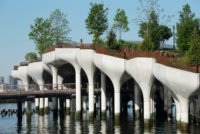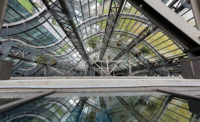Brooklyn, New York
Smith Street, in Brooklyn, New York’s Carroll Gardens neighborhood, has evolved over the course of the past decade from a rugged urban commercial strip peppered with family shoe stores, bodegas, and windowless Italian social clubs, to the area’s restaurant row, playing host to a mix of both serious and theme-heavy establishments, from top-ranked restaurants run by ambitious chefs to a tiki bar named the Zombie Hut. When Sean Josephs, a sommelier, and Michael Tsoumpas, a bourbon collector, decided in 2007 to open a bourbon bar and restaurant serving refined comfort food in a 19th-century row house here, they approached the Manhattan-based firm Berman Horn Studio and expressed their desire for an environment influenced by the Southern whiskey-making tradition. Unlike some of their neighbors, however, the restaurateurs wished to accomplish this with a light touch, without being overtly referential or kitsch.
In the spring of 2008, the two owners and the design partners, Brad Horn and Maria Berman, headed down to Kentucky, commonly known as bourbon’s birthplace, to explore the Bluegrass State’s urban enclaves and rural scenery and visit a couple of distilleries. “We became inspired by the landscapes and the textures and colors of the process of distillation,” says Horn, “and decided our design should capture that spirit.” Named Char No. 4 after the practice of burning the insides of oak bourbon barrels prior to aging (with No. 4 being the most intense level of charring), the restaurant opened in September 2008. Abstract references begin on the facade, which is clad in water-jet-cut steel that resembles barrel staves, and continue inside—enhanced by a rich aroma rising from a basement smoker—to a palette of warm materials, such as the oatmeal-colored grass cloth that lines the walls and alludes to grain mash.
Lighting became a central architectural element for the project, largely because the long and narrow, 1,100-square-foot space was not conducive to creating separate zones of intimacy. “It was not an afterthought,” says Horn. “Much of our design circulated around the lighting,” adds Berman. “It allowed us to create a space that’s bigger than its size.”
Inspired by the geometry of bourbon barrels, the team came up with an abstraction of their shape, based on their actual dimensions, and repeated the cylindrical form (36 inches tall and 24 inches in diameter) over and over in the front bar area with 32 custom pendants made of craft paper mounted on Mylar and illuminated by 100-watt incandescent A-lamps on dimmers. This sculptural arrangement continues the datum of the lower-ceilinged back dining room and the soffit that runs around the perimeter of the front room, equalizing the difference in height between the two spaces. Using the fixtures to create a “soft ceiling,” the designers give diners a sense of the soaring, 16-foot height of the bar area while not oppressing them. This soft ceiling also acts as a baffle between the lively restaurant and the apartments directly above, and bathes the space in a tawny light that bounces off bronze-tinted mirrors.
Custom brass sconces illuminated by 40-watt incandescent A-lamps are mounted at eye level adjacent to the bar in the front and a little lower alongside seating in the dining room at the back, and reference the pendants. More overtly historic than their larger counterparts, the sconces use a paper with a smaller-scaled grain. The third and final lighting elements are the LEDs that illuminate walnut shelves behind the bar displaying Char No. 4’s pièce de résistance: more than 150 whiskeys (that started out as one of the owners’ personal collection). Horn and Berman, who did not work with a lighting designer, note that they experimented with a range of LED intensities and sizes to get the desired effect: a somewhat cool quality of light that contrasts with the golden luminescence of the incandescent fixtures and highlights the subtle variations in color among the array of bottles.
Berman Horn Studio’s deft handling of simple materials and its creation of a lighting scheme that performs on multiple levels responds—in a language that is firmly contemporary while being respectful of the location’s traditional roots—to the owners’ desire to subtly capture the spirit of Southern comfort while meeting the challenges of the small, almost cavelike space. In the aging process, it is the charring of the barrels that produces bourbon’s rich amber hue. Here, the designers have employed controlled lighting focused on the honey-toned part of the visible spectrum to harness the drink’s essence and flood Char No. 4 in its warm glow.





Post a comment to this article
Report Abusive Comment